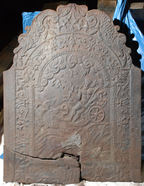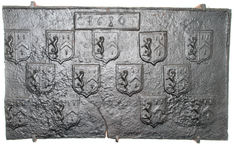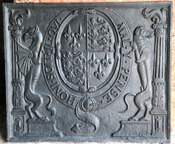-
827
Description: Arched rectangular central panel with bead-and-pellet edging on a broad fillet; pictorial scene of a figure in a chariot drawn by birds, above a ground, and with clouds over; arched rectangular border with fillet edging; alternating acanthus leaves with symmetrical curled lines, possible initial centre bottom; on top, two mirrored sea serpents; plain extension panels to each side.
Notes: The figure is that of Jupiter, holding a bolt of lightning, who is sometimes portrayed in a chariot drawn by eagles; width without extension panels - 477mm.
Inscription: [?]N
- Decoration tags:
- 'Dutch' (shape)
- fillet (edging)
- whole carved pattern
- extension panels
- pictorial
- mythological
- monogram
- text
- animals
- humans
- objects
Manufactured: in the early-18th century in England.
Current location: Westgate, Winchester, Hampshire, England.
Museum number: WINCM:LH 5705 (part of the Winchester Museums museum group)
- Attached to series:
- British 'Dutch' style firebacks
- N series
-
1008
Description: Rectangular; twisted rope edging on top and (probably both) sides; cavetto-moulded-edged rectangle top centre, enclosing date between initials; 13 shields of Ayloffe impaling Sulyard in three rows (5-4-4), the bottom row having a gap between the middle pair of shields; Ayloffe: sable, a lion rampant Or, collared gules, between three crosses formy of the second; Sulyard: argent, a chevron gules between three pheons inverted sable.
Notes: William Ayloffe (c1535-1584) of Bretons, Hornchurch, Essex, Justice of the Court of Queen’s Bench, married (c1560) Jane, dau. of Sir Eustace Sulyard, of Runwell, Essex. About 110mm of the left side has broken off suggesting an original width of 1340mm. The initials 'CT' are likely to be those of Charles Tyler, a founder whose working life and that of his family have strong parallels with the occurrence of these firebacks.
Inscription: C 1610 T
Arms: Ayloffe impaling Sulyard (William Ayloffe of Bretons, Hornchurch)
- Decoration tags:
- rectangular (shape)
- rope (edging)
- carved stamps
- individual letters
- individual numbers
- armorial
- text
Manufactured: in 1610 possibly at Bedgebury Furnace, Goudhurst in the Weald area of England.
Current location: Wye College, High Street, Wye, Kent, England.
- Attached to series:
- Ayloffe series
- Personal armorial firebacks
-
1010
Description: Rectangular with ovolo-moulded edging; central oval shield of England (quarterly France modern and England) surrounded by the Garter with the additional word 'IL', and supported by a dragon on the dexter side and a greyhound on the sinister side, each standing on a plinth; to each side of the armorial group is a column with the upper part of the shaft fluted and the lower part foliate; each has an Ionic capital and a moulded pedestal; fire issues from the top of the capital.
Notes: The style of carving is not typical of English design but is similar to other firebacks bearing Tudor armorials that were probably cast in Wallonia.
Inscription: HONI SOIT IL QVI MAL Y PENSE
Arms: English royal Tudor (prob. Henry VIII)
- Decoration tags:
- rectangular (shape)
- ovolo (edging)
- whole carved pattern
- armorial
- royal
Manufactured: in the 17th century possibly in the Wallonia area of Belgium.
Current location: Westpreussenring 1, Saarbrucken, Saarland, Germany.
Citation: Carpentier, H., 1912, Plaques de Cheminées (Paris, published by the author).
- Attached to series:
- Tudor royal armorial firebacks
- Continental Tudor royal armorial firebacks


